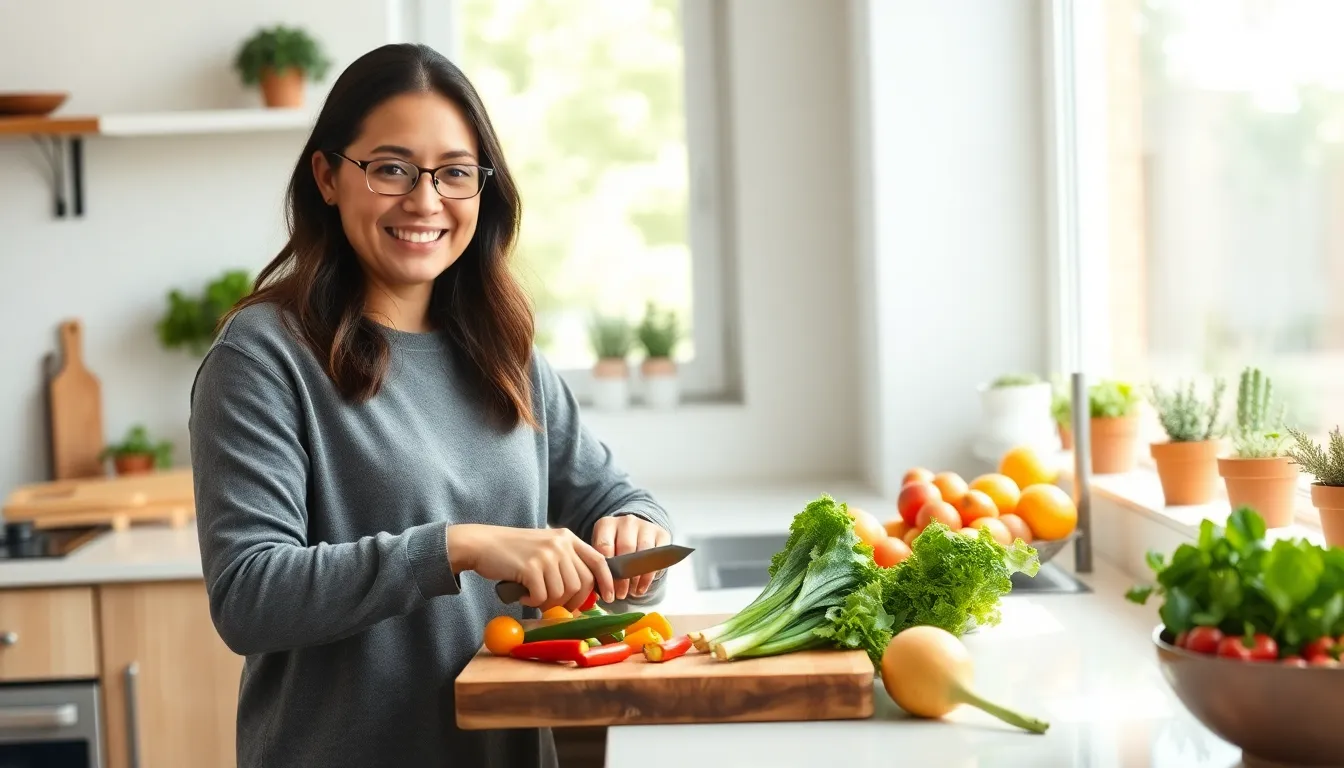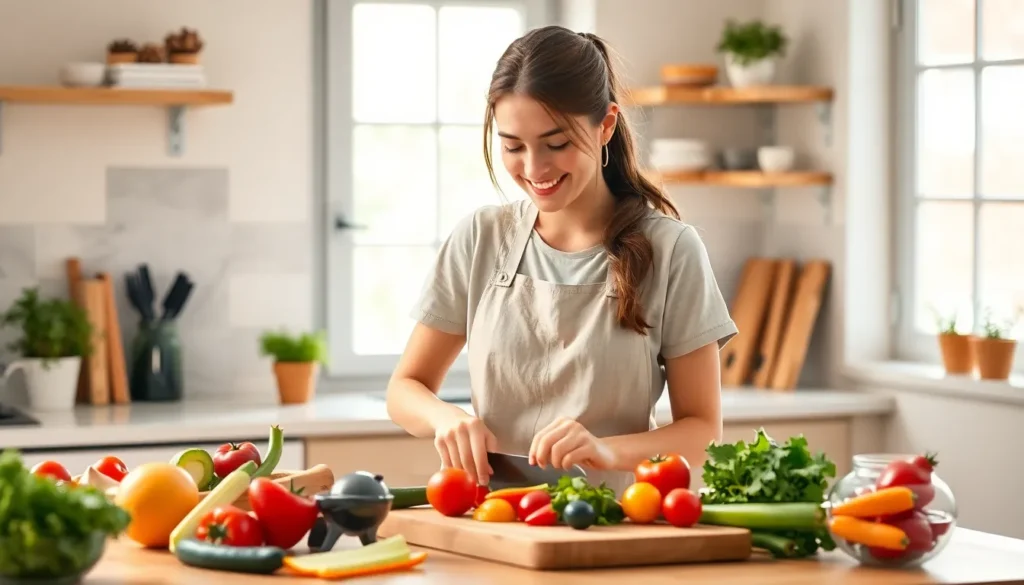In a world where multitasking reigns supreme, mindful cooking offers a delicious escape from the chaos. Imagine chopping vegetables while serenading your senses with the sizzle of garlic in the pan. It’s not just about whipping up dinner; it’s about savoring the moment and finding joy in the process.
Mindful cooking invites everyone to ditch the distractions and embrace the art of culinary creation. It transforms the kitchen into a sanctuary where flavors dance and creativity flourishes. Whether you’re a seasoned chef or a kitchen novice, this approach can turn meal prep into a delightful adventure. So grab your apron and get ready to stir up some mindfulness—because who knew cooking could be both nourishing and a little zen?
Mindful Cooking
Mindful cooking refers to the practice of engaging fully with the cooking process. This approach emphasizes presence, awareness, and enjoyment while preparing meals. Practitioners focus on each step, from selecting ingredients to plating the final dish. Distractions diminish as attention remains on the sensory experiences involved.
Individuals practicing mindful cooking cultivate a deeper connection to food. The textures, aromas, and colors of ingredients become prominent. Emphasis on seasonal and local produce enhances appreciation for the meal’s origins. Techniques such as chopping, stirring, and seasoning transform into meditative actions.
Mindful cooking encourages an exploration of flavors and creativity. Experimentation with new recipes or adjusting traditional ones fosters innovation. Sharing the process with others can create valuable bonding moments. Additionally, cooking with friends or family nurtures communal aspects of meal preparation.
This practice promotes healthier eating habits. By focusing on cooking, individuals become more aware of nutritional choices. Conscious decisions about what to include in meals often emerge. Portion sizes and balance between food groups can lead to improved well-being and satisfaction.
Ultimately, mindful cooking transforms a routine chore into an enriching experience. Both skilled chefs and novices find solace in the kitchen. Adopting this philosophy offers opportunities for personal growth and joy. By emphasizing presence in each culinary moment, individuals discover food’s nourishing potential.
Benefits of Mindful Cooking

Mindful cooking brings numerous advantages that enhance both the cooking experience and overall well-being.
Enhanced Focus and Creativity
Engagement in mindful cooking fosters enhanced focus. Concentrating on cooking techniques allows individuals to explore their creativity. Drawing inspiration from seasonal ingredients encourages innovative dishes. Preparing meals thoughtfully leads to unique flavor combinations. Practitioners often describe this process as meditative, creating a calming environment. Each moment spent chopping vegetables or stirring sauces heightens awareness of the cooking journey. Embracing the art of cooking not only connects one to the food but also inspires confidence in culinary skills. Transforming a simple recipe into a personal creation reflects an individual’s imagination and personality.
Improved Health and Nutrition
Mindful cooking significantly improves health and nutrition. Awareness of ingredient choices leads to healthier meals. By focusing on fresh, whole foods, practitioners create balanced diets. Portion sizes become clearer, supporting a better relationship with food. Engaging with the cooking process encourages reading labels, researching nutritional values, and understanding ingredients. Such mindfulness may also help in reducing processed food intake. As individuals learn about their food source, they develop a deeper appreciation for nourishment. This shift toward wholesome ingredients contributes to long-term health benefits, including increased energy and vitality.
Techniques for Practicing Mindful Cooking
Mindful cooking techniques enhance the overall cooking experience, allowing individuals to connect deeply with their food. These methods foster a sense of presence and tranquility throughout the cooking process.
Preparing Your Cooking Environment
Creating a calm cooking space sets the stage for mindful cooking. Clear countertops of clutter before starting. This action promotes focus on the ingredients. Arrange utensils and tools for easy access to maintain flow. Natural light or soft music can further enhance the atmosphere, making the kitchen inviting. Keep distractions minimal, turning off notifications and limiting phone use. Engaging with the surroundings creates a centered mindset and encourages creativity.
Engaging Your Senses
Staying present in the moment heightens sensory experiences during cooking. Observe colors and textures as you chop vegetables or mix ingredients. Pay attention to the aromas released from spices and herbs layered in the pot. Feel the temperature of the ingredients, noting how they change as they cook. Sound plays a crucial role; listen to the sizzling of ingredients in a hot pan. Focusing on these sensory details strengthens the connection to the food and enhances enjoyment. Engaging each sense allows individuals to cultivate a deeper appreciation for the culinary art.
Mindful Cooking Recipes
Exploring mindful cooking through specific recipes enhances the overall experience. Engaging in creative culinary practices leads to more rewarding meal preparation.
Easy Recipes to Get Started
Begin with simple dishes that emphasize fresh, seasonal ingredients. A vegetable stir-fry offers a colorful display, where participants can notice vibrant textures and aromas. Focus on irregular cuts and varied colors to promote sensory engagement. A fruit salad encourages mixing flavors and enhancing natural sweetness, presenting a perfect opportunity for mindful eating. Engaging with basic recipes allows individuals to nurture their culinary skills while enjoying the cooking process.
Advanced Techniques for Seasoned Cooks
For those with more experience, experimenting with fermentation can deepen the connection to food. Making pickles or sauerkraut introduces the art of preserving, creating unique flavors and textures. Crafting homemade bread provides an opportunity to explore the science of fermentation while stimulating all five senses. Incorporating techniques like sous-vide can enhance flavor retention and texture, allowing for precision in cooking. These advanced practices not only challenge skills but also foster greater awareness of the ingredients and processes involved.
Conclusion
Mindful cooking invites individuals to embrace the kitchen as a sanctuary rather than a chore. This practice nurtures creativity and connection to food while enhancing overall well-being. By focusing on the sensory elements of cooking and minimizing distractions, anyone can transform meal preparation into a fulfilling experience.
As one explores the beauty of seasonal ingredients and engages in the art of cooking, it becomes a joyful journey of discovery. The benefits extend beyond the plate, fostering healthier eating habits and a deeper appreciation for nourishment. Mindful cooking isn’t just about making meals; it’s about cultivating a lifestyle that celebrates the simple pleasures of food and the joy of creation.

